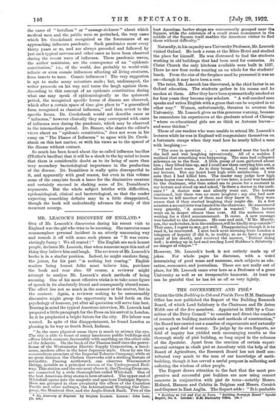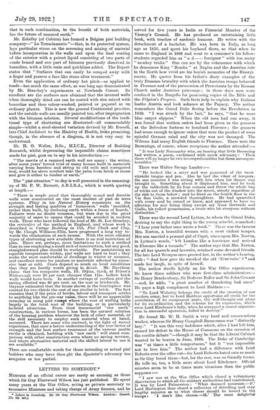l'PLE GOVERNMENT AND PISA*
UNDER the title Building in Cob and Piad de Terre H.M. Stationery Office has now published the Report of the Building Research Board, of which Lord Salisbury is the Chairman and Sir Aston Webb one of the five members. Appointed in 1920 by a Com- mittee of the Privy Council " to consider and direct the conduct of research on building materials and methods of construction," the Board has carried out a number of experiments and naturally spent a good deal of money. To judge by its own Reports, no field of inquiry has yielded such encouraging results as the thorough study of piso building, so long urged in the columns of the Spectator. Apart from the erection of certain experi- mental cottages in chalk pig at Amesbury with the help of the Board of Agriculture, the Research Board has not itself con- tributed very much to the sum of our knowledge of earth- building, though it has served a useful purpose in collecting and collating the wisdom of other people.
The Report draws attention to the fact that the most pro- gressive and successful ping builders are now using cement concrete in conjunction with pied de terre—notably Messrs. Holland, Mennen and Cubitts in Belgium and Messri. Cornish and Gaymer in East Anglia. The Report adds : " It is probable • Building in Cob and Pied de Terre. "Building Research Board" Special Report, No. 5, London B.M. StatiOney Othee. ?
that in such combination, to the benefit of both materials, lies the future of rammed earth."
Mr. Eahelby (of Cubitta) has formed a Belgian piss building company—" Le Terradamente "—that, in its protected system, lays particular stress on the screening and mixing of material before incorporation in the walls and upon the final coating of the exterior with a patent liquid consisting of two parts of crude benzol and one part of bitumen previously dissolved in benzoline, with a little resin and quicklime added. The Report states that " Surfaces that can easily be scraped away with a finger nail possess a face like stone after treatment."
Even the application of ordinary hot pitch—as applied to roads—has much the same effect, as was long ago demonstrated by Mr. Strachey's experiments at Newlands Corner. So excellent are the surfaces now obtained that the internal walls when thoroughly dried out can be coated with size mixed with benzoline and then colour-washed, painted or papered as on ordinary plaster. This is now the general Continental practice, and the outside walls are usually painted too, after impregnation with the bitumen solution. Several modifications of the tradi- tional type of shuttering are illustrated—all commendably simple—whilst a steel-sheeted variation devised by Mr. Russell, late Chief Architect to the Ministry of Health, looks promising, though, in the absence of a diagram, it is not very easy to understand.
Mr. H. 0. Weller, B.Sc., M.I.C.E., Director of Building Research, whilst deprecating the impossible claims sometimes made for pis4, goes on to say in his introduction :— " The merits of a rammed earth wall are many • the writer, after some years' forced trial of many houses built in materials varying from bamboo and string to old rails and corrugated iron, would for sheer comfort take the palm from brick or stone and give it either to timber or earth."
The " pise, situation " to-day is well presented in the summing- up of Mr. P. W. Barnett, A.R.LB.A., which is worth quoting at length:— "There is ample proof that thoroughly sound and durable walls were constructed on the most ancient of pis) de terre systems. Pliny in his Natural History comments on the strength and lasting qualities of formoceon ' walls moulded, rather than built, by enclosing earth within a frame of boards.' Failures were no doubt common, but were due in the great majority of cases to causes that could be avoided in modern work. Those who have followed the lead of Mr. St. Loe Strachey, the revivalist of the method in England, and whose work is described in Cottage Building in Cob, Pise Chalk and Clay, by Mr. Clough Williams-Ellis, have progressed a long way to- wards the elimination of such causes. With the more efficient types of shuttering now available there is no real restriction of plan. There are, perhaps, more limitations to such a method than to one employing a small unit of construction, but any good, straightforward plan should be workable. For maintaining an equable temperature within, piss walls are hard to beat ; they make the most comfortable of dwellings in winter or summer, and excellent stores for produce or materials affected by exces- sive heat or cold. Costs depend so much on local conditions that they are hardly worth giving in detail. Mr. Davidson claim' that his composite walls, lft. 10i-ins. thick, at Prince's Risboro ugh were 35 per cent. cheaper than I lin. hollow brick walls would have been. In another cottage of earthen pisd the saving effected was 80 per cent. on the cost in brickwork. Mr. Gaymer estimated that the house shown in the frontispiece was erected for two-thirds the cost of one similar in brick. The fact remains that if the price of bricks, labour and transport settles to anything like the pre-war value, there will be no appreciable economy in using piss except where the cost of walling bulks largely in the total cost of the building, or in particularly isolated situations. From timd immemorial 'raw earth' construction, in various forms, has been the natural solution of the housing problem wherever the lack of other material, or the skill necessary to employ such material when at hand, occurred. There are some who contend, in the light of recent experience, that once a better understanding of the true factor of strength and the best surface treatment of the various usable earths is obtained, building with 'raw earth' will stand com- parison with other construction even where no saving accrues, and where alternative material and the skilled labour to use it are available."
These are comfortable words for those intending or actual pia) builders who may have thou ght the Spectator's advocacy too sanguine or too partial.



































 Previous page
Previous page